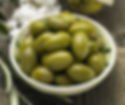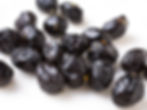A Beginner's Guide to Olives: Varieties Worth Exploring
- IICCI_Communications
- Sep 11, 2020
- 3 min read
Olive cultivars, or varieties of olives, play a significant role in determining an olive's colour, shape, and flavour. There are no green olive trees! The colour of an olive is an indication of its ripeness. Green olives ripen and become black olives. Or rather, they transform from green to light brown, to a vibrant red and purple, to the deepest, darkest black.

In general, the darker the olive, the riper it was when it was plucked from the tree. Green olives are usually picked at the start of the harvest season, in September and October in the northern hemisphere. They have a firm texture and lovely, nutty flavour. Black(er) olives are picked in November and December, sometimes as late as January, and they're softer, richer, and meatier.
There are literally hundreds of olive cultivars growing throughout the world, with at least 400 known varieties in Italy alone but only a few of them have gained popularity. Some of them are:
Kalamata

The king of Greek table olives, beloved and popular Kalamatas are a deep purple, with tight, snappy, shiny skin, and a pretty almond shape. They're typically preserved in red wine vinegar, red wine, and/or olive oil for a distinctive rich, smoky, fruity flavour. This variety is a great candidate for tapenades, but I also loved them served simply with some roasted cauliflower.
Castelvetrano

Castelvetrano olives are Italy's most prevalent snack olive. A vibrant green Sicilian olive comes from the olive variety called Nocellara del Belice. They're often referred to as dolce (sweet). Instead of brining or salt-curing, these are treated with lye before rinsing and storing. They have a Kermit-green hue, meaty, buttery flesh, and a mild flavour. Consider serving them with sheep's milk cheese and a glass of crisp white wine.
Cerignola

These gigantic green olives are harvested in Cerignola, in Italy's Puglia region, the heel of the boot. They are crisp and fantastically buttery. Their hefty size renders them the ability to be easily stuffed—they play especially well with garlic, cheese, capers, and anchovies.
Nyon

These petite, jet-black olives from the south of France are heart-stopping. First, dry-cured, then aged in brine, the plump, wrinkly olives are meaty, just-a-bit bitter, and packed with an aromatic flavour. They're especially delicious dressed with Provençal olive oil and fragrant herbs like rosemary and thyme.
Liguria

Also called Taggiasca olives, this petite variety packs a big flavour punch for their size. They're grown in Liguria, in Italy's north-western-most region, a few miles away from France's Niçoise olive region, and the olives are indeed similar. They're usually cured with an aromatic mixture of bay leaves, rosemary, and thyme.
Gaeta

These small, purplish-brown, wrinkled olives from Puglia have soft, tender flesh and a tart, citrusy flavour. Gaeta's can be either dry-cured (shrivelled, chewy) or brine-cured (plump, juicy). They are enjoyed served over spaghetti with capers and pine nuts, or simply served out of a bowl for snacking.
Olives have a strikingly low sugar content compared with other stone fruits like cherries and peaches. Raw olives are extremely bitter due to the presence of oleuropein. They undergo a curing process before they're ready for us to eat. Olive curing is actually more like fermentation—it's the conversion of the olive's natural sugars into lactic acid.
Ways to cure olives:
Brine Curing

Fully ripened, dark purple or black olives are gradually fermented in brine (i.e. saltwater). This takes major time—up to a year. Brine-cured olives are often sweet and full of depth since the brine acts to intensify the fruit's natural flavours.
Water Curing

Soaking, rinsing in plain water, and repeating, and repeating again...this method is the slowest of all, and consequently quite rare. Some producers begin their curing process in a water bath, and then move their olives into a seasoned brine.
Dry Curing

These olives get packed in salt for a month or longer. The salt pulls the moisture and bitterness from the olives. The salt is then removed, and sometimes the olives get bathed in olive oil to keep them juicy and plump. Dry-cured olives have a deeply concentrated flavour, and a wrinkly, prune-like appearance. Oil-cured olives are dry-cured olives that get macerated, or softened, in oil for several months.
Sun / Air Curing

In some rare cases, olives can be fermented either on the branch or, once picked, by basking in the sunshine. The Thrubolea variety from Crete is an example of an olive left to cure on the tree.
We are certain that you’d have tried at least one of these varieties. If not then what are you waiting for?
Get in touch with us today to order your favourite Madama Oliva products from our import
partner and get them home delivered all over India.
Contact us at italicswineclub@indiaitaly.com or call at +91 9811392313 for more information on our list of offerings, and place your order on this link, and get up to 25% discount.
Souces: seriouseats, eataly, eatingwell






